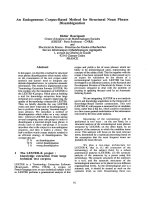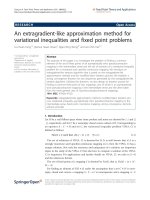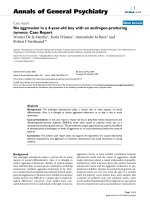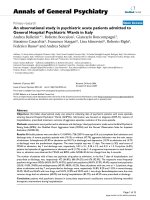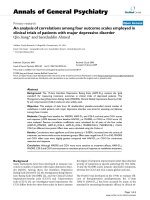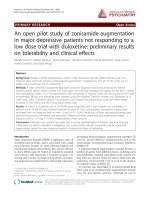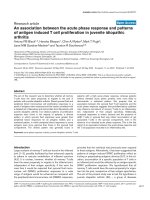Báo cáo y học: " An efficient in vitro-inoculation method for Tomato yellow leaf curl virus" ppsx
Bạn đang xem bản rút gọn của tài liệu. Xem và tải ngay bản đầy đủ của tài liệu tại đây (965.7 KB, 9 trang )
Al Abdallat et al. Virology Journal 2010, 7:84
/>Open Access
RESEARCH
BioMed Central
© 2010 Al Abdallat et al; licensee BioMed Central Ltd. This is an Open Access article distributed under the terms of the Creative Com-
mons Attribution License ( which permits unrestricted use, distribution, and reproduc-
tion in any medium, provided the original work is properly cited.
Research
An efficient
in vitro
-inoculation method for
Tomato
yellow leaf curl virus
Ayed M Al Abdallat*
1,2
, Hmoud S Al Debei
1
, Heba Asmar
1
, Samar Misbeh
1
, Ayat Quraan
1
and Anders Kvarnheden
3
Abstract
Background: Tomato yellow leaf curl virus (TYLCV) is a member of the family Geminiviridae, genus Begomovirus. To test
the infectivity of TYLCV in tomato plants, an improved protocol for inoculation of in vitro-cultured tomato plants was
developed.
Results: A TYLCV isolate was cloned, sequenced and used to construct a 1.8-mer infectious clone. Three weeks old
microshoots of TYLCV-susceptible tomato plants were inoculated with Agrobacterium tumefaciens harboring the
infectious clone for the TYLCV isolate. After two weeks, the TYLCV symptoms started to appear on the in vitro-
inoculated plants and the symptoms became more severe and pronounced eight weeks post-inoculation. The method
was used efficiently to uncover the resistance mechanism against TYLCV in Solanum habrochaites accession LA 1777, a
wild tomato known for its high resistance to whitefly and TYLCV.
Conclusions: The reported in vitro-inoculation method can be used to screen tomato genotypes for their responses to
TYLCV under controlled conditions and it will be a useful tool for better understanding of the TYLCV biology in tomato
plants.
Background
Since it was first reported in the Jordan valley [1], the
tomato yellow leaf curl disease (TYLCD), caused by the
Tomato yellow leaf curl virus (TYLCV) and related
viruses, has become a serious problem that affects tomato
(Solanum lycopersicum) worldwide. TYLCV is a member
of the family Geminiviridae, genus Begomovirus and it is
transmitted to tomato by the whitefly Bemisia tabaci in a
persistent and circulative manner [2]. The management
of the disease in tomato production areas is difficult and
expensive and the control measurements are focused
mainly on the whitefly control and are based on insecti-
cide treatments and/or the use of physical barriers [3].
One of the best ways to reduce TYLCV damage is to
breed plants resistant to both the virus and the vector.
Breeding programs for TYLCV-resistant cultivars are
based on the transfer of TYLCV resistance genes from
wild tomato species into cultivated tomato [4]. Previous
studies have revealed the presence of resistance mecha-
nisms against the virus in wild tomato species that are
controlled by multiple genes [4-6]. For instance, the
TYLCV resistance in S. chilense is controlled by a major
gene, termed Ty-1, and at least two other modifier genes
[7]. However, the progress in the breeding program has
been slow, primarily due to the complexity of TYLCV-
resistance genetics and the virus-vector-host interactions
[5]. The complexity of TYLCV resistance is reflected by
the presence of different resistance mechanisms against
the virus and the whitefly. In addition, TYLCD may be
caused by different strains of TYLCV as well as other
begomovirus species, such as Tomato yellow leaf curl Sar-
dinia virus (TYLCSV).
To test the infectivity of TYLCV and to understand
mechanisms of TYLCV resistance in plants, several
methods for in vivo screening have been developed such
as natural field infection, whitefly inoculation in cages,
inoculation with the virus using leaf or stem agroinfiltra-
tion or biolistic inoculation [8]. In many instances, such
methods have proven to be laborious and pose a potential
threat to the environment. For instance, several suscepti-
ble tomato plants had escaped TYLCV infection using
the method of natural field infection even 90 days after
transplanting [9], while with whitefly inoculation in
cages, it might be difficult to control the inoculum pres-
* Correspondence:
1
Department of Horticulture and Crop Science, Faculty of Agriculture,
University of Jordan, Amman 11942, Jordan
Full list of author information is available at the end of the article
Al Abdallat et al. Virology Journal 2010, 7:84
/>Page 2 of 9
sure [10]. In addition, such natural inoculation methods
are not efficient for screening wild tomato species due to
their non-preference by whiteflies. In addition, vector
activity, virus multiplication and symptom development
are affected by the prevalent environmental conditions
during and after greenhouse or field inoculation. Agroin-
filtration of stems or leaves are laborious, difficult and
inefficient in some tomato genotypes [11,12]. Using
biolistic inoculations, discrepancies in results related to
plant species have also been reported [13-15]. Above all,
testing for TYLCV resistance in transgenic plants using
in vivo inoculation methods is difficult in open environ-
ment or non-specialized greenhouse conditions due to
strict regulations for genetically modified organisms.
Therefore, there is a need to establish controlled inocula-
tion protocols to prevent any unfavorable spread of the
viruses to the surrounding environment, especially when
testing new viral strains or recombinants.
Two previous reports have described the development
of viral inoculation systems suitable for in vitro plants
[16,17]. With the described systems, it has been possible
to inoculate successfully plants grown in vitro using a
mechanical approach. In this study, we report the devel-
opment and use of an efficient in vitro method suitable
for TYLCV inoculation of tomato. The principle for the
new inoculation method depends on dipping the basal
part of the plant in a solution containing agrobacteria
with an infectious TYLCV clone. The method was used
successfully to inoculate susceptible tomato plants with
TYLCV and to test for TYLCV resistance in wild tomato
plants.
Methods
Cloning of a TYLCV genome
Leaves from a tomato plant showing TYLCD symptoms
were collected from greenhouse-grown plants. Total
DNA was extracted from the collected leaves using a
CTAB method [18]. The overlapping primer method was
used for the amplification of a full-length TYLCV DNA
genome with the polymerase chain reaction (PCR) as
described previously [19]. In this method, two designed
primers, TYJU fwd (5'-TAAATACCATGGCCGCG-
CAGCGGAATACACGACGTTC-3') and TYJU Rev (5'-
TATAATCCATGGAGACCCATAAGTATTGTCATT-
GAGGGTGA-3'), that overlap a conserved NcoI site (in
italics) in the C1 gene of TYLCV were used in combina-
tion with the genomic DNA extract prepared from
TYLCV-infected tomato leaf tissue in a PCR. The reac-
tions were performed in a 25 μL volume containing 100
ng genomic DNA, 2.5 μL of dNTPs (100 μM), 5 μL of 5×
PCR, 0.5 μM of each primer and 0.25 μL of 5 U/μL GoTaq
DNA polymerase (Promega, Madison, Wisconsin). The
PCR conditions were 94°C for 5 min, followed by 40
cycles of 94°C for 30 min, 55°C for 1 min, and 72°C for 1
min, and a final 10 min extension at 72°C. The PCR-
amplified DNA fragments were digested with the restric-
tion enzyme NcoI and the resulting ~2.8 kb DNA frag-
ment was inserted into the same restriction site of the
plasmid pCAMBIA1380 (Cambia, Canberra, Australia).
Positive recombinant plasmids that contained an approx-
imately 2.8-kb full-length TYLCV clone were fully
sequenced using an ABI 3730XL by Macrogen (Seoul,
Korea). Positive clones were named pTYLCV- [JU] and
one positive clone was used in subsequent work.
Construction of TYLCV infectious clone
An infectious TYLCV clone was constructed using a 1.8-
mer genome-length copy of TYLCV obtained from
pTYLCV- [JU]. For this purpose, a 2.35 kb EcoRI/NcoI
fragment of pTYLCV- [JU] was first cloned into the
pCAMBIA1380 binary plasmid, which had been digested
with EcoRI and NcoI to create pBTY [JU]P. Then, a 2.8 kb
NcoI fragment of pTYLCV- [JU], the full-length TYLCV
clone, was ligated into an NcoI-linearized pBTY [JU]P
yielding pBTY [JU], a binary plasmid containing a 1.8-
mer of TYLCV- [JU].
In vitro culture of plants
Seeds of the TYLCV- susceptible S. lycopersicum line
"NS16" were obtained from an advanced breeding pro-
gram developed at the Jordanian National Seed Com-
pany. The NS16 tomato line originates from a cross
between S. lycopersicum cv. Guardian (developed by the
Enza-Zaden Seed Company), a highly TYLCV-suscepti-
ble tomato and S. lycopersicum cv. Elegro (developed by
the Asgrow Seed Company), a TYLCV-resistant tomato
(N. Abu Al Roz, personal communication). NS16 is a
determinate tomato plant that yields dark red fruits of
220-250 g. Seeds of S. lycopersicum cv. Moneymaker were
obtained from Gourmet Seed International Seed Com-
pany, USA. The seeds of S. habrochaites accession LA
1777 were kindly provided by C.M. Rick, TGRC, Davis,
USA.
Seeds from plants of NS16, Moneymaker and LA 1777
were surface sterilized with 70% ethanol for one minute
followed by soaking for 15 minutes in 3.5% sodium
hypochlorite plus 0.1% Tween-20. Seeds were rinsed 6
times with sterile water and then placed in a plastic vessel
containing MS medium consisting of MS salt [20], 50 mg/
l myo-insitol, 2 mg/l thiamine HC1, 0.5 mg/l pyridoxine
HCl, 0.5 mg/l nicotinic acid, 30 g/l sucrose and 7 g/l agar,
with pH value adjusted to 5.8 before autoclaving. Seeds
were germinated in a growth room (24°C under cool
white fluorescent lights, 50-100 μEm
-2
sec
-1
, with a pho-
toperiod of 16 hours light/8 hours darkness). After 21
days, the tomato plantlets were used for the inoculation
experiments.
Al Abdallat et al. Virology Journal 2010, 7:84
/>Page 3 of 9
Inoculation methods
Competent cells of Agrobacterium tumefaciens strain
GV3101 [21] were transformed by electroporation with
either pCAMBIA1380 (negative control) or pBTY [JU].
Bacteria were grown for 24 hours at 28°C in Luria-Bertani
(LB) media supplemented with appropriate antibiotics.
Bacterial cells were harvested by centrifugation and
resuspended to a final OD
600
of 0.25 in liquid MS medium
(without agar) supplemented with 100 μM acetosyrin-
gone. Into a sterile Petri dish, 10 ml of the bacterial sus-
pension were poured. Microshoots (around 2.0 cm in
length) were excised from 21 days old tomato plantlets
and their basal parts were dipped for 30 seconds in the
agrobacterial suspension. The inoculated microshoots
(20 microshoot/inoculation test) were transferred into
solid MS medium supplemented with 100 μM acetosyrin-
gone and co-cultivated with the bacteria for 48 hours.
After 48 hours of co-cultivation, microshoots were
washed three times in sterile distilled water containing
filter-sterilized cefotaxim (500 mg/l) and then transferred
to glass tubes containing 15 ml of solid MS medium sup-
plemented with 500 mg/l cefotaxim, an antibiotic that
kills bacterial cells. The inoculated microshoots were
monitored for development of TYLCD symptoms for 8
weeks post-inoculation.
The effect of inoculum density on the TYLCV-infec-
tion efficiency was investigated using three different
OD
600
levels. For this purpose, agrobacterium cells were
harvested and diluted to a final OD
600
of 0.125, 0.25 or 0.5
in liquid MS medium supplemented with 100 μM aceto-
syringone and the bacteria were then co-cultivated with
NS16 tomato microshoots and monitored for develop-
ment of TYLCD symptoms.
The effect of the dipping method on TYLCV-infection
efficiency was also tested. For this purpose, either the
basal part of a NS16 tomato microshoot was dipped for
30 seconds or the entire microshoot was soaked for 15
minutes in the agrobacterium solution (OD
600
of 0.25)
and then washed three times in sterile distilled water con-
taining filter-sterilized cefotaxim (500 mg/l). The
explants were then co-cultivated and monitored for the
development of TYLCD symptoms as described above.
To inoculate greenhouse grown tomato plants with
TYLCV, a leaf agroinfiltration method was used. For this
purpose, the bacterial suspension was prepared as
described above and was then infiltrated into the lower
side of leaves of 2-weeks old plants using a 1 ml needle-
less syringe. Inoculated plants were observed for the
development of TYLCD symptoms for eight weeks post-
inoculation.
TYLCV detection in inoculated plants
To confirm the presence of TYLCV DNA in tissue-cul-
ture infected plants, PCR was performed using specific
TYLCV primers. DNA extracts from the in vitro-inocu-
lated plants were isolated as described by Doyle and
Doyle [18]. The DNA extracts were used as template for
PCR amplification (as described above) of a 450 bp long
DNA fragment from the C1 gene using the primers
TYMF (5'-AAGCGCTTCCAAATAAATTG-3') and
TYMR (5'-TACTAATTCTTTAATGATTC-3'). The PCR
products were subjected to electrophoresis in a 1% aga-
rose gel.
To verify presence of the full-length circular single-
stranded genome of TYLCV in inoculated plants, rolling
circle amplification (RCA) [22] using bacteriophage
Phi29 DNA polymerase (New England BioLabs, MA,
USA) was carried out as follows: 1 μg of extracted total
DNA was added to 5 μl of dNTPs (100 μM) and 5 μl ran-
dom hexamers (2 pmol/μl). The mixture was heated to
95°C for 5 minutes, chilled on ice, and combined with 5 μl
of reaction buffer plus 5 units of the Phi29 DNA poly-
merase. Water was added to a final volume of 50 μl. The
reaction mixture was incubated for 18 h at 30°C, followed
by inactivation of the enzyme at 65°C for 10 minutes. The
amplified DNA, containing tandem repeats of the
TYLCV genome, was separated in a 1% agarose gel. In
addition, the amplified DNA was digested with NcoI in
order to detect a ~2.8 kb band representing a linearized
TYLCV genome in the inoculated plants.
Results
Establishment of the TYLCV in vitro-inoculation method
The complete genome of TYLCV was isolated from a
tomato plant showing TYLCD symptoms using the over-
lapping primer method. The positive pTYLCV- [JU]
clones were analyzed using several restriction enzymes
and positive clones were completely sequenced. The iso-
late was found to show high sequence identity (99.4%)
with the TYLCV-Mld isolate [23]. A 1.8-mer DNA copy
from the isolated TYLCV genome was cloned into
pCAMBIA1380 to produce the infectious clone pBTY
[JU]. The infectious clone was tested successfully in
greenhouse-grown plants of the TYLCV-susceptible
tomato line "NS16" using the leaf agroinfiltration method
(data not shown). Four weeks after leaf agroinfiltration
with pBTY [JU], typical symptoms of TYLCD were
observed in 13/15 of the inoculated plants, while tomato
plants agroinfiltrated with pCAMBIA1380 remained
symptomless.
To est abli sh the TYLC V in vitro-inoculation method,
basal parts of three weeks old microshoots obtained from
in vitro-grown TYLCV-susceptible NS16 tomato plant-
lets were dipped for 30 seconds in solutions containing
agrobacterium transformed with either the infectious
clone pBTY [JU] or empty binary plasmid. The inocu-
lated in vitro microshoots were monitored for develop-
ment of TYLCV symptoms for 8 weeks post-inoculation.
Al Abdallat et al. Virology Journal 2010, 7:84
/>Page 4 of 9
Table 1 summarizes the results obtained from three inde-
pendent experiments. Over 85% of the in vitro-inoculated
tomato microshoots with pBTY [JU] had typical TYLCD
symptoms, while all of the tomato microshoots inocu-
lated with the pCAMBIA1380 plasmid remained symp-
tomless and continued their growth normally. However,
15% of the in vitro-inoculated tomato microshoots were
considered healthy with no obvious TYLCD symptoms
and they continued to grow normally (Table 1). The
results obtained showed the feasibility to inoculate effi-
ciently in vitro tomato plants with TYLCV and typical
symptoms of TYLCD with leaf curling and yellowing
were observed.
For symptom development, NS16 tomato microshoots
inoculated with the empty plasmid did not show any
TYLCD symptoms and continued to grow normally (Fig-
ure 1A). The development of TYLCD symptoms in some
plants was first observed 2 weeks post inoculation (Figure
1B). After 4 weeks, NS16 tomato plants in vitro-inocu-
lated with pBTY [JU] continued to display symptoms of
stunting, upward leaf curling and yellowing (Figure 1C).
After 8 weeks, the TYLCV-inoculated plants showed pro-
nounced TYLCD symptoms when compared with plants
inoculated with the pCAMBIA1380 plasmid (Figure 1D).
The presence of TYLCV in the in vitro-inoculated plants
showing TYLCD symptoms was verified by PCR and
RCA (Figure 2). The TYLCD symptoms in in vitro-inocu-
lated plants were similar to in vitro-cultured plants
derived from nodal explants of tomato plants inoculated
with TYLCV in the greenhouse (data not shown). The in
vitro-inoculated plants with TYLCD symptoms were kept
in culture for 6 months indicating the feasibility to main-
tain TYLCV in vitro using this method (Figure 1E). In
addition, it was possible to transfer the in vitro-inocu-
lated plants to greenhouse conditions after two weeks of
acclimatization.
Furthermore, the in vitro-inoculation method was
tested successfully and similar results were obtained with
other TYLCV-susceptible tomato cultivars, such as Mon-
eymaker (Table 1). The in vitro-inoculated Moneymaker
plants showed similar TYLCD symptoms when com-
pared to the in vitro-inoculated line NS16 microshoots
after eight weeks of inoculation (data not shown). How-
ever, the in vitro-inoculated Moneymaker and "line
NS16" plants showed variation in infection percentages
(Table 1). In general, the in vitro-inoculated Moneymaker
plants had higher infection percentage values when com-
pared to the in vitro-inoculated line NS16 plants.
The effect of inoculum density on the TYLCV-infec-
tion efficiency was tested using three different OD
600
(0.125, 0.25 or 0.5). The results from two independent
experiments using NS16 tomato microshoots showed
that bacterial densities of both 0.25 and 0.5 produced a
high percentage of TYLCV infected plants (over 70% of
inoculated plants) compared to a density of 0.125 (50% of
inoculated plants) (Additional file 1). In some instances,
plant death was observed (30% of inoculated plants)
when an OD
600
of 0.5 was used due to agrobacteria over-
growth (Additional file 1). These results indicate that an
OD
600
of 0.25 is considered optimum for inducing
TYLCD symptoms in the in vitro-inoculation method.
In the treatment where the whole plant was completely
soaked in the agrobacterium solution, the percentage of
TYLCV infectivity was very low compared to the treat-
ment with 30 seconds of basal dipping (Additional file 2).
The complete soaking of NS16 microshoots resulted in
the browning and necrosis of all inoculated microshoots
eight weeks post-inoculation (data not shown). In fact,
62.5% of plants soaked in the agrobacterium solution died
four weeks post-inoculation (Figure 3A and Additional
file 2). In addition, the surviving inoculated soaked plants
(37.5% of inoculated plants) showed terminal bud death
and the newly developed shoots from the axillary buds
were infected and showed typical TYLCD symptoms
(Figure 3B and Additional file 2). In some instances, the
soaked plants showed overgrowth of agrobacteria four
Table 1: Agroinoculation of in vitro-cultured NS16 and Moneymaker tomato plants with the infectious TYLCV clone pBTY
[JU] and the negative control pCAMBIA1380.
Construct Genotype
Experimenta (% infected plantsb)
I II III Average
pCAMBIA1380 NS16 0 [0/20] 0 [0/20] 0 [0/20] 0 [0/60]
Moneymaker 0 [0/20] 0 [0/20] 0 [0/20] 0 [0/60]
pBTY [JU] NS16 85 [17/20] 80 [16/20] 90 [18/20] 85 [51/60]
Moneymaker 95 [19/20] 100 [20/20] 95 [19/20] 96.7 [58/60]
a
In each experiment, 20 plants were inoculated.
b
Data were recorded 8 weeks post-inoculation. Infected plants percentages were determined from the numbers in brackets.
Al Abdallat et al. Virology Journal 2010, 7:84
/>Page 5 of 9
Figure 1 Symptoms on in vitro-cultured NS16 tomato plants inoculated with the infectious TYLCV clone pBTY [JU]. (A) Tomato plant 4 weeks
after inoculation with pCAMBIA1380 (negative control). (B) Tomato plant 2 weeks after inoculation with pBTY [JU]. (C) Tomato plant 4 weeks after in-
oculation with pBTY [JU]. (D) Tomato plant 8 weeks after inoculation with pCAMBIA1380 (left) or pBTY [JU] (right). (E) Tomato plant 6 months after
inoculation with pBTY [JU].
C
EE
Al Abdallat et al. Virology Journal 2010, 7:84
/>Page 6 of 9
weeks post-inoculation, while with basal dipping no bac-
terial overgrowth was observed (data not shown). These
results indicate that dipping the basal part of the explant
is sufficient and suitable for the purpose of in vitro-inocu-
lation of tomato plants with TYLCV.
Testing the in vitro inoculation method with TYLCV-
resistance plants
To test the in vitro-inoculation method with TYLCV-
resistant wild tomato plants, in vitro cultures of S. habro-
chaites accession LA 1777 were established and micro-
shoots were inoculated and monitored for TYLCD
symptoms as described above. S. habrochaites LA 1777 is
known for its high levels of resistance against the whitefly
insect, the transmission of the virus by the insect and its
tolerance to TYLCV and it is commonly used in breeding
programs to produce tomato plants with improved resis-
tance against TYLCV [24]. In contrast to the results
obtained with the in vitro-inoculation of susceptible
tomato plants, all LA 1777 microshoots (results of two
experiments with 20 microshoots per experiment) did
not show any TYLCD symptoms even 4 weeks after inoc-
ulation and they continued to grow normally and simi-
larly to microshoots inoculated with the empty binary
plasmid (Figure 4). Although LA 1777 plants were symp-
tomless, PCR and RCA analysis showed the presence of
TYLCV DNA in inoculated plants verifying the presence
of a resistance mechanism [23] against the virus prevent-
ing TYLCD symptoms development (Figure 5). These
results indicate the possibility to identify the mechanism
of resistance against TYLCV in wild tomato genotypes
using in vitro cultures.
Discussion
In this study, an efficient in vitro-inoculation method for
TYLCV was developed that is suitable for screening dif-
ferent tomato genotypes for their responses to TYLCV.
The presented in vitro-inoculation method proved to be
efficient and reliable. Such method is needed to overcome
pitfalls reported for other TYLCV inoculation methods
[3,8]. For instance, previous reports discourage the use of
whitefly-inoculation methods due to difficulties related
to controlling infection pressure, the escape of some
plants from the infection and the influence of environ-
mental conditions on TYLCD symptom development
[9,10]. Furthermore, the in vitro-inoculation method can
be adapted to inoculate plant species considered to be
"non-host" by the whiteflies [8,10]. Inoculation methods
depending on stem or leaf agroinfiltration under green-
house conditions require extra measurements to avoid
external infection and are inefficient in some plants
[11,12,14]. Discrepancy in results of TYLCV inoculation
using particle bombardment has been shown previously.
For instance, Morilla et al. [14] successfully inoculated
tomato plants with DNA of TYLCV- [Alm] from Alme-
Figure 2 Detection of TYLCV DNA in tissue-cultured NS16 tomato
plants after inoculation with the infectious TYLCV clone pBTY
[JU]. (A) Agarose gel showing PCR products (450 bp) amplified with
the primer pair TYMF/TYMR from DNA extracts of plants inoculated in
vitro with TYLCV. Lanes 1-4: DNA extracts from plants inoculated with
pCAMBIA1380 (negative control); Lanes 5-8: DNA extracts from plants
inoculated with pBTY [JU]. C: pBTY [JU] plasmid (positive control). M:
Low range DNA marker (Fermentas). (B) Agarose gel showing amplifi-
cation products after rolling circle amplification (RCA) with DNA of
plants inoculated with TYLCV in vitro. Lanes 1-2: DNA extracts from
plants inoculated with pCAMBIA1380 (negative control); Lanes 3-4:
DNA extracts from plants inoculated with pBTY [JU]. M: High range
DNA marker (Fermentas). (C) Agarose gel showing TYLCV DNA after di-
gestion of the RCA products with NcoI. Lanes 1-2: DNA extracts from
plants inoculated with pCAMBIA1380 (negative control); Lanes 3-4:
DNA extracts from plants inoculated with pBTY [JU]. M: High range
DNA marker (Fermentas).
Figure 3 Inoculation of in vitro-cultured NS16 tomato plants with
the infectious TYLCV clone pBTY [JU] using the soaking method.
(A) Dead tomato plant 4 weeks after inoculation. (B) Growth of axillary
bud in tomato plant 4 weeks after inoculation.
Al Abdallat et al. Virology Journal 2010, 7:84
/>Page 7 of 9
ria, while Ramos et al. [15] were unsuccessful even
though they used a similar approach with TYLCV- [CU]
from Cuba and TYLCSV. Furthermore, the efficiency of
TYLCV infectivity using particle bombardment differed
with the plant species [13]. Testing the in vitro-inocula-
tion system on two different genotypes revealed the pres-
ence of variation in infection percentages (Table 1). Such
variation in infection rates might indicate variability in
responses to TYLCV infection between the two geno-
types.
The described in vitro system is suitable for in vitro
storage of TYLCV-infected plant material (Figure 1E).
With this respect, Pelah et al. [25] reported the establish-
ment of callus cultures from TYLCV-infected tomato
plants that were suitable for in vitro storage of TYLCV-
infected callus up to 8 months. Similar tissue culture
approaches were developed for the purpose of Tobacco
mosaic virus (TMV) propagation in hairy root cultures of
Nicotiana benthamiana where the hairy root cultures
were directly inoculated by the addition of the virus to
the culture medium [26]. Therefore, the described in
vitro-inoculation method can be used for prolonged stor-
age of infected material and can be used in exchanging
infected plant materials between locations.
Two previous reports describe systems suitable for the
inoculation of in vitro-grown plants with viruses. Mazier
et al. [16] have described a simple and efficient system for
in vitro inoculation of lettuce plants with Lettuce mosaic
virus (LMV). The principle of their method relies on the
mechanical inoculation of in vitro-grown lettuce plantlets
using latex fingers dipped in sap extract from green-
house-grown infected plants. In another study, nodal cut-
tings from in vitro-cultured potato, tomato and tobacco
plants have been infected in vitro with Potato virus Y
(PVY) using mechanical and grafting inoculation [17].
However, the PVY symptoms on the in vitro-infected
plants were not as obvious as those observed on green-
house-grown infected plants. Both systems are based on
mechanical inoculation and this is not applicable for
Figure 4 Lack of symptoms for in vitro-cultured plants of Solanum
habrochaites accession LA 1777 inoculated with the infectious
TYLCV clone pBTY [JU]. (A) Plant of S. habrochaites accession LA 1777
4 weeks after inoculation with pCAMBIA1380 (negative control). (B)
Plant of S. habrochaites accession LA 1777 4 weeks after inoculation
with pBTY [JU].
Figure 5 Detection of TYLCV DNA in tissue culture plants of Sola-
num habrochaites accession LA 1777 after inoculation with the in-
fectious TYLCV clone pBTY [JU]. (A) Agarose gel showing PCR
products (450 bp) amplified with the primer pair TYMF/TYMR from
DNA extracts of plants inoculated in vitro with TYLCV. Lanes 1-3: DNA
extracts from plants inoculated with pCAMBIA1380 (negative control);
Lanes 4-6: DNA extracts from plants inoculated with pBTY [JU]. C: pBTY
[JU] plasmid (positive control). M: Low range DNA marker (Fermentas).
(B) Agarose gel showing amplification products after rolling circle am-
plification (RCA) with DNA of plants inoculated with TYLCV in vitro.
Lane 1: DNA extract from plant inoculated with pCAMBIA1380 (nega-
tive control); Lane 2: DNA extract from plant inoculated with pBTY [JU].
M: High range DNA marker (Fermentas). (C) Agarose gel showing TYL-
CV DNA after digestion of the RCA products with NcoI. Lane 1: DNA ex-
tract from plant inoculated with pCAMBIA1380 (negative control);
Lanes 2: DNA extracts from plants inoculated with pBTY [JU]. M: High
range DNA marker (Fermentas).
Al Abdallat et al. Virology Journal 2010, 7:84
/>Page 8 of 9
TYLCV, which cannot be transmitted by mechanical
inoculation. The in vitro-inoculation method described
here needs agrobacterium to deliver the infectious
TYLCV clone into in vitro-grown tomato plants. Similar
to our approach, agroinoculation of aseptically grown N.
benthamiana plants for the purpose of virus-induced
gene silencing has been successful and targeted genes
were silenced one week post-inoculation [12].
Similar to the method developed by Russo & Salck [17],
the reported method is suitable for initial screening of
virus resistance in transgenic plants. It can reduce the
time needed to evaluate the performance of transgenic
plants and it is suitable for testing such plants under con-
trolled environment and thus meeting the regulations for
testing transgenic plants. In addition, the current
described in vitro-inoculation method can be used to test
the responses of different plant species to inoculation
with TYLCV strains not prevalent in certain geographical
areas. This would prevent the spread of viral strains to
new areas, which is a risk issue when using inoculations
in greenhouses or fields. The described method can facil-
itate studying the biological interactions between differ-
ent tomato genotypes and different begomoviruses. In
addition, the developed in vitro-inoculation method can
be adapted to infect tomato plants simultaneously with
different viral strains or species, which is difficult to per-
form using natural or whitefly-inoculation methods. Fur-
thermore, the method is suitable for testing the
specificity of interaction between different tomato geno-
types and TYLCV strains avoiding cross contamination
with other viruses and pathogens that are common using
inoculations in greenhouses or fields. Additionally, the
described in vitro-inoculation method is aseptic and it
will eliminate the presence of other pathogens that might
cause overlapping symptoms with the TYLCD in vivo.
The TYLCD symptoms were obvious on the in vitro-
inoculated plants, although sometimes overlap with the
tissue culture-induced phenotype was observed (Figure
1). However, the TYLCD symptoms of plants inoculated
in vitro were similar to in vitro-cultured plants derived
from nodal explants of tomato plants inoculated with
TYLCV in the greenhouse (data not shown). The TYLCV
symptoms were absent when the in vitro-inoculation
method was tested on wild tomato plants known for their
resistance against TYLCV. Therefore, it is necessary to
detect the virus using molecular tools such as PCR,
Southern blot analysis or RCA.
The in vitro-inoculation method described here can be
used to understand the mechanisms of resistance against
TYLCV in wild tomato genotypes. Using this method
with S. habrochaites LA 1777, a wild tomato showing
resistance to both whitefly and TYLCV [24], the presence
of a TYLCV resistance mechanism was unmasked (Figure
4). Using the in vitro-inoculation method, the TYLCV-
inoculated LA 1777 microshoots were symptomless for
TYLCD, but tested positive for TYLCV using PCR and
RCA (Figure 5). LA 1777 plants grown under greenhouse
conditions and subjected to inoculation with viruliferous
whiteflies and PCR analysis revealed the presence of both
immune (virus is not detectable in the plant) and tolerant
(virus is detectable in the plant, but the TYLCD symp-
toms are absent) mechanisms against TYLCV [unpub-
lished results], which is consistent with previous reports
[24]. Several attempts to transmit TYLCV to LA 1777
through grafting with infected tomato plants or natural
infection under greenhouse conditions failed [unpub-
lished results]. The current method can overcome such
limitations related to incompatibility between scion and
stock or natural inoculation difficulties due to whitefly
non-preference. According to Vidavsky & Czosnek [24],
the mechanisms of resistance in LA 1777 are expressed at
the whitefly-plant interface (viral transmission) and
internally in the plant (TYLCD symptoms development);
therefore, by using natural inoculation methods, the
resistance at the whitefly-plant interface will mask the
resistance toward the virus inside the plant. Using the
described in vitro-inoculation method, it was possible to
overcome such limitation and it was feasible to uncover
the natural resistance of LA 1777 to TYLCV. This is in
general agreement with the results of Kheyr-Pour et al.
[27], where in vivo agroinoculation was used to break the
TYLCV resistance in LA 1777.
Conclusions
In this study, an efficient method suitable for in vitro
inoculation of tomato plants with TYLCV was developed.
The method was used efficiently to unmask the TYLCV
resistant in wild tomato. The current method allows the
storage and propagation of infected tomato plants under
proper controlled conditions. The described in vitro
method will be recommended for initial screens of trans-
genic plants with improved resistance against TYLCV.
Additional material
Competing interests
The authors declare that they have no competing interests.
Authors' contributions
AMA conceived the research, performed most of the experiments, and wrote
the manuscript; HSD collected the samples and monitored the TYLCD symp-
toms development; SM helped in the molecular work; HA and AQ helped in
Additional file 1 Effect of inoculum density on in vitro-cultured NS16
tomato plants inoculated with the infectious TYLCV clone pBTY [JU]. A
table showing the responses of tomato microshoots following the inocula-
tion with three different inoculum densities of agrobacteria harboring the
infectious TYLCV clone pBTY[JU].
Additional file 2 Effect of inoculation method on in vitro-cultured
NS16 tomato plants inoculated with the infectious TYLCV clone. A
table showing the responses of tomato microshoots to the inoculation
with the infectious TYLCV clone pBTY [JU] using two different methods.
Al Abdallat et al. Virology Journal 2010, 7:84
/>Page 9 of 9
the tissue culture work; AK developed the conceptual aspects of the work and
edited the manuscript; All authors read and approved the final manuscript.
Acknowledgements
The authors wish to thank the Jordanian National Seeds Production company
for kindly providing seeds of tomato line "NS16". We are grateful to C.M. Rick,
TGRC, Davis, USA for the seeds of Solanum habrochaites accession LA 1777. This
work was supported in part by a grant from the Hamdi Mango Center for Sci-
entific Research, University of Jordan and by the Swedish Research Links Pro-
gramme (Swedish International Development Cooperation Agency and
Swedish Research Council).
Author Details
1
Department of Horticulture and Crop Science, Faculty of Agriculture,
University of Jordan, Amman 11942, Jordan,
2
Agricultural Biotechnology
Laboratories, Hamdi Mango Center for Scientific Research, University of Jordan,
Amman 11942, Jordan and
3
Department of Plant Biology and Forest Genetics,
Uppsala BioCenter SLU, Box 7080, SE-750 07 Uppsala, Sweden
References
1. Cohen S, Harpaz I: Periodic rather than continual acquisition of a new
tomato virus by its vector, the tobacco whitefly (Bemisia tabaci
Gennadius). Entomol Exp Appl 1964, 7:155-166.
2. Czosnek H, Ber R, Antignus Y, Cohen S, Navot N, Zamir D: Isolation of the
Tomato yellow leaf curl virus - a geminivirus. Phytopathology 1988,
78:508-512.
3. Lapidot M, Friedmann M: Breeding for resistance to whitefly-
transmitted geminiviruses. Ann Appl Biol 2002, 140:109-127.
4. Vidavski FS: Exploitation of resistance genes found in wild tomato
species to produce resistant cultivars; Pile up of resistant genes. In
Tomato Yellow Leaf Curl Virus Disease Edited by: Czosnek H. The
Netherlands: Springer; 2007:363-372.
5. Ji Y, Scott JW, Hanson P, Graham E, Maxwell DP: Sources of resistance,
inheritance, and location of genetic loci conferring resistance to
members of the tomato-infecting begomoviruses. In Tomato Yellow
Leaf Curl Virus Disease Edited by: Czosnek H. The Netherlands: Springer;
2007:343-362.
6. Lapidot M, Polston JE: Resistance to Tomato yellow leaf curl virus in
Tom ato. In Tomato Yellow Leaf Curl Virus Disease Edited by: Czosnek H. The
Netherlands: Springer; 2007:503-520.
7. Zamir D, Ekstein-Michelson I, Zakay Y, Navot N, Zeidan M, Sarfatti M, Eshed
Y, Harel E, Pleban T, van-Oss H, Kedar N, Rabinowitch HD, Czosnek H:
Mapping and introgression of a tomato yellow leaf curl virus tolerance
gene, TY-1. Theor 1994, 88:141-146.
8. Lapidot M: Screening for TYLCV-resistant plants using whitefly-
mediated inoculation. In Tomato Yellow Leaf Curl Virus Disease Edited by:
Czosnek H. The Netherlands: Springer; 2007:329-342.
9. Vidavsky F, Leviatov S, Milo J, Rabinowitch HD, Kedar N, Czosnek H:
Response of tolerant breeding lines of tomato, Lycopersicon
esculentum, originating from three different sources (L. peruvianum, L.
pimpinellifolium and L. chilense) to early controlled inoculation by
tomato yellow leaf curl virus (TYLCV). Plant Breeding 1998, 117:165-169.
10. Pico B, Diez MJ, Nuez F: Evaluation of whitefly-mediated inoculation
techniques to screen Lycopersicon esculentum and wild relatives for
resistance to tomato yellow leaf curl virus. Euphytica 1998, 101:259-271.
11. Liu YL, Schiff M, Dinesh-Kumar SP: Virus-induced gene silencing in
tomato. Plant 2002, 31:777-786.
12. Ryu CM, Anand A, Kang L, Mysore KS: Agrodrench40: a novel and
effective agroinoculation method for virus-induced gene silencing in
roots and diverse Solanaceous species. Solanaceous 2004:322-331.
13. Lapidot M, Weil G, Cohen L, Segev L, Gaba V: Biolistic inoculation of
plants with Tomato yellow leaf curl virus DNA. J Virol Methods 2007,
144:143-148.
14. Morilla G, Janssen D, Garcia-Andres S, Moriones E, Cuadrado IM, Bejarano
ER: Pepper (Capsicum annuum) is a dead-end host for tomato yellow
leaf curl virus. Phytopathology 2005, 95:1089-1097.
15. Ramos PL, Guevara-Gonzalez RG, Peral R, Ascencio-Ibanez JT, Polston JE,
Arguello-Astorga GR, Vega-Arreguin JC, Rivera-Bustamante RF: Tomato
mottle Taino virus pseudorecombines with PYMV but not with ToMoV:
implications for the delimitation of cis - and trans -acting replication
specificity determinants. Arch 2003, 148:1697-1712.
16. Mazier M, German-Retana S, Flamain F, Dubois V, Botton E, Sarnette V, Le
Gall O, Candresse T, Maisonneuve B: A simple and efficient method for
testing Lettuce mosaic virus resistance in in vitro cultivated lettuce. J
Virol Methods 2004, 116:123-131.
17. Russo P, Slack SA: Tissue culture methods for the screening and analysis
of putative virus-resistant transgenic potato plants. Phytopathology
1998, 88:437-441.
18. Doyle JJ, Doyle JL: A rapid DNA isolation procedure from small
quantities of fresh leaf tissue. Phytochem 1987, 19:11-15.
19. Patel V, Roja MR, Paplomatas EJ, Gilbertson RL: Cloning biologically-
active geminivirus DNA using PCR and overlapping primers. Nucleic
Acids Res 1993, 21:1325-1326.
20. Murashige T, Skoog F: A revised medium for rapid growth and bioassays
with tobacco tissue culture. Physiol 1962, 15:473-497.
21. Koncz C, Schell J: The promoter of Ti -DNA gene 5 controls the tissue-
specific expression of chimeric genes carried by a novel type of
Agrobacterium binary vector. Mol Gen Genet 1986, 204:383-396.
22. Inoue-Nagata AK, Albuquerque LC, Rocha WB, Nagata T: A simple
method for cloning the complete begomovirus genome using the
bacteriophage phi29 DNA polymerase. J Virol Methods 2004,
116:209-211.
23. Antignus Y, Cohen S: Complete nucleotide-sequence of an infectious
clone of a mild isolate of Tomato yellow leaf curl virus (TYLCV).
Phytopathology 1994, 84:707-712.
24. Vidavsky F, Czosnek H: Tomato breeding lines resistant and tolerant to
Tomato yellow leaf curl virus issued from Lycopersicon hirsutum.
Phytopathology 1998, 88:910-914.
25. Pelah D, Altman A, Czosnek H: Tomato yellow leaf curl virus-DNA in
callus-cultures derived from infected tomato leaves. Plant Cell Tissue
Organ Cult 1994, 39:37-42.
26. Shih SM, Doran PM: In vitro propagation of plant virus using different
forms of plant tissue culture and modes of culture operation. J
Biotechnol 2009, 143:198-206.
27. Kheyr-Pour A, Gronenborn B, Czosnek H: Agroinoculation of tomato
yellow leaf curl virus (TYLCV) overcomes the virus resistance of wild
Lycopersicon species. Plant 1994, 112:228-233.
doi: 10.1186/1743-422X-7-84
Cite this article as: Al Abdallat et al., An efficient in vitro-inoculation method
for Tomato yellow leaf curl virus Virology Journal 2010, 7:84
Received: 5 March 2010 Accepted: 29 April 2010
Published: 29 April 2010
This article is available from: 2010 Al Abdallat et al; licensee BioMed Central Ltd. This is an Open Access article distributed under the terms of the Creative Commons Attribution License ( ), which permits unrestricted use, distribution, and reproduction in any medium, provided the original work is properly cited.Virology Journal 2010, 7:84

